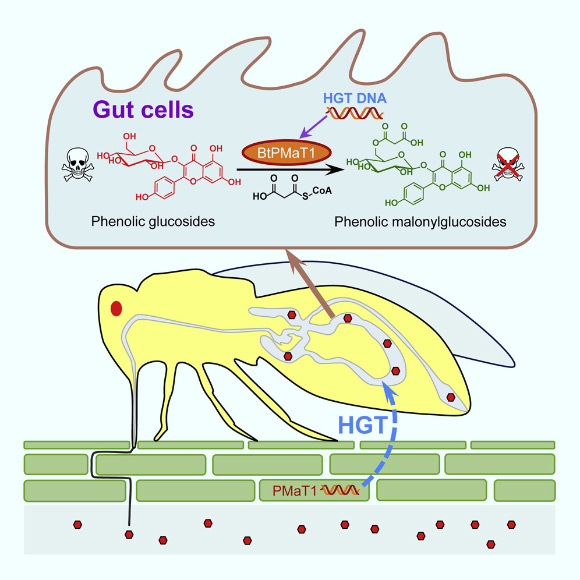The silverleaf whitefly (Bemisia tabaci) incorporated a gene called BtPMaT1 from plants into its genome roughly 35 million years ago and now uses it to neutralize toxins plants use to defend themselves against insects, allowing the whitefly to feed on the plants safely.

Silverleaf whiteflies (Bemisia tabaci) carry a plant-derived phenolic glucoside malonyltransferase gene BtPMaT1, which enables the insects to neutralize phenolic glycosides in host plants. Image credit: Xia et al., doi: 10.1016/j.cell.2021.02.014.
Plants protect themselves with a vast array of toxic compounds, yet most plants serve as food for insects.
The evolutionary processes that allow herbivorous insects to resist plant defenses remain largely unknown.
The silverleaf whitefly is a cosmopolitan agricultural pest that attacks at least 600 different species of plants worldwide.
This insect also vectors several serious plant pathogenic viruses and is an excellent model to study the molecular mechanisms involved in overcoming plant defenses.
“This seems to be the first recorded example of the horizontal gene transfer of a functional gene from a plant into an insect,” said Dr. Ted Turlings, a researcher at the University of Neuchâtel.
“You cannot find this gene, BtPMaT1, which neutralizes toxic compounds produced by the plant, in any other insect species.”
“Plants probably use BtPMaT1 within their own cells to store their noxious compounds in a harmless form, so the plant doesn’t poison itself.”
Dr. Turlings and colleagues used a combination of genetic and phylogenetic analyses, to reveal that roughly 35 million years ago, silverleaf whiteflies stole this defense gene, granting the insect the ability to detoxify these compounds for themselves.
“We think a virus within the plant may have taken up the BtPMaT1 gene and, after ingestion by a whitefly, the virus then must have done something inside the insect whereby that gene was integrated into the whiteflies genome,” Dr. Turlings said.
“Of course, this is an extremely unlikely event, but if you think about millions of years and billions of individual insects, viruses, and plants across time, once in a while this could happen, and if the acquired gene is a benefit to the insects, then it will be evolutionarily favored and may spread.”
“One of the questions we’ve been asking ourselves is how these insects acquired these incredible adaptations to circumvent plant defenses, and with this discovery we have revealed at least one reason as to why,” he added.
The researchers developed a small RNA molecule that interferes with the whiteflies’ BtPMaT1 gene, making the whiteflies susceptible to the plant’s toxic compounds.
“The most exciting step of this design was when our colleagues genetically manipulated tomato plants to start producing this RNA molecule,” Dr. Turlings said.
“Once the whiteflies fed on the tomatoes and ingested the plant-produced RNA, their BtPMaT1 gene was silenced, causing 100% mortality of the insect, but the genetic manipulation had no impact on the survival of other insects that were tested.”
The findings appear in the journal Cell.
_____
Jixing Xia et al. Whitefly hijacks a plant detoxification gene that neutralizes plant toxins. Cell, published online March 25, 2021; doi: 10.1016/j.cell.2021.02.014







